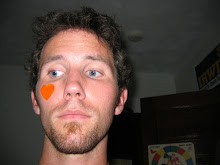Before meeting my local pals, I spent the day taking pictures around the city. Most of these pictures were of spilled food. Food left out on the street. Food smashed up against the sidewalk. Food growing cold on a cement bench. There was something... poignant about these forgotten leftovers. Scoff if you will. But each one told a story, whether imagined or real. That styrofoam container of spaghetti? A construction worker's lunch, left almost untouched after he remembered he told his wife he'd stop eating meatballs for 30 days after "the meatball incident." The smushed banana? A group of neighborhood teens conducting an experiment: To see if a banana peel actually makes someone slip (they forgot to unpeel it first).
Am I making these up? Of course. Could they be the truth? Sure, why not. Might the real stories be more interesting than I could ever make up? Oh yes. Are the true reasons behind these food gaffes actually quite pedestrian, boring or merely accidental? Maybe. But maybe George Washington didn't actually cut down a cherry tree. You think about that. And while you are, I'll imagine the polka-dotted smear those fallen cherries made on the dirt field outside Mount Vernon, and how they looked just like a constellation of bullet holes...
And that's the other thing. Some of the scenes of food I saw were, in one way, beautiful. Maybe it was the unexpectedness of the image. Maybe the medium used, so often sucked down or nibbled at or twirled on a fork, was always associated with one thing (eating) so that now, to see it splayed out on the cement like Jackson Pollack's supper, was to see it in an entirely new way.
So here's the deal. I'm going to try and post one picture a week of food I've found* in some form, whether lost, crushed, emptied, scattered--any form outside of its usual, pre-eaten structure. The image might resemble something unexpected, like seeing a Chinese dragon in a cumulus cloud. It might trace a pretty line along the sidewalk. It might evoke an imagined story--How did that split pea soup get there? It might just be a funny picture. Whatever the food, however devastating or minor the spill, think about what it says to you. And then tell me about it. Comment on the picture with your own Origin story. Or share a moment when that same disaster happened to you, and the stirring consequences. ("And then I cleaned it up with a paper towel. I was never the same again.")
We eat food everyday. We also toss it out of car windows, or leave it on the picnic table, or shoot for the trash bin but miss. My hope is that we can start to notice such littered gems for what they are, or what they might be, and fully appreciate the potential of these Edible Wrecks.
Here's my first:

* Yes, this idea is somewhat similar to FOUND, a magazine out of my old college town, Ann Arbor, which collects 'found' items (lists, notes, polaroids, etc.) that tell a story. Davy Rothbart and Jason Bitner are good people. If they spill their Mac 'n Cheese into a compelling pattern on the floor, I hope they tell me about it.









